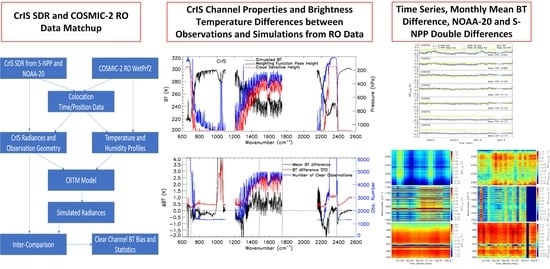Assessment of the Consistency and Stability of CrIS Infrared Observations Using COSMIC-2 Radio Occultation Data over Ocean
Abstract
:1. Introduction
2. Data Characteristics from CrIS and COSMIC-2 RO Measurement
2.1. Information Contents from CrIS Measurement
2.2. COSMIC-2 RO Data Measurement Characteristics
3. Data Collocation and CrIS Channel Selection
4. Results
4.1. Bias and Stability between CrIS Measurements and Simulated BT from COSMIC-2 Retrievals
4.2. BT Monthly Mean Difference for All Selected Channels in CrIS Three Bands
5. Discussion
- (a)
- Bias and uncertainty in CrIS SDR data. The double differences, ranging from −0.05 K to 0.15 K in the LWIR temperature sounding channels between CrIS observations on NOAA-20 and on S-NPP using simulations as a transfer, mainly come from the radiometric calibrations, including the nonlinearity correction, ringing artifacts associated with the calibration algorithm and raw interferogram data points used, polarization correction, and the internal calibration target (ICT) model [1,6,9]. These channels also have larger instrument noise due to the CrIS instrument design compared to other LWIR channels [13,14].
- (b)
- Biases and uncertainties in the COSMIC-2 RO data retrievals. Although RO raw data are traceable to a unit of time, the temperature and water vapor profiles derived from the RO observations are not. As discussed in Section 2.2, the accuracy of the temperature and water vapor profiles depends on (1) how to reduce the instrument thermal noise effectively and the ionospheric noise above 35 km and (2) how to increase the receivers’ ability to track the multitude of signals and the retrieval algorithms’ ability to disentangle these signals below 10 km, during the bending angle/refractivity retrieval process [17,44]. The results shown in Section 3 demonstrated that the times for algorithm updates in the UCAR 1DVAR can be detected in the time series of the BT difference between CrIS observations and simulations using the RO data, resulting in differences in the bias characteristics. It is also shown that the larger BT difference and standard deviation for these selected water vapor channels in the MWIR band (see Figure 4 and Figure 8) than those from the temperature sounding channels in the LWIR and SWIR bands might result from the water vapor profiles in the 1DVAR RO retrieval system significantly fitting to the a priori and being potentially impacted by the super-refraction conditions below 5 km [46,50].
- (c)
- Biases and uncertainties in the CRTM simulation. CRTM is a fast radiative transfer model that uses a regression method to calculate the atmospheric gaseous absorption based on line-by-line simulation with a representative training dataset. The simulation accuracy is highly dependent on the model input atmospheric and surface conditions. Since only temperature and water vapor profiles are available from the COSMIC-2 RO products, the potential CrIS channels evaluated in this study are limited. To reduce the biases and uncertainties from the CRTM simulation, we selected CO2 temperature sounding channels in the CrIS LWIR and SWIR bands with WFPH greater than 10 km, where RO data can provide highly accurate temperature profiles, and water vapor channels in the MWIR band with cloud sensitivity height above ~5 km, with clear conditions and over oceans. However, there still are several residual biases and uncertainties related to the simulation: (1) clear sky detection uncertainties from the detection algorithm, whereby the cloud contamination would greatly impact the radiance simulation for the water channels and low WFPH temperature sounding channels; (2) use of an input CO2 profile with the default concentration (~384 ppmv) which is far less than the amount in the real atmosphere during the two years from October 2019 to September 2021—therefore, the impact cannot be negligible for CO2 temperature sounding channels; (3) daytime NLTE simulation for the CO2 4.3 µm absorption band, which is considered in the CRTM but is not accurate enough to remove the biases and seasonal biases related to solar zenith angles [42,47]; (4) input atmospheric temperature profiles from the RO retrieval not extending high enough (only up to 60 km), which would impact the radiance simulation for these channels with very high WFPH.
- (d)
- Biases and uncertainties related to the data collocation and sampling size. In this paper, the collocated minimum distance is calculated using the CrIS FOV pixel location and the COSMIC-2 RO profiles’ perigee location (occultation point) instead of the altitude location of the peak weighting function of each channel as was done in [38]. Since we evaluated hundreds of CrIS channels, it is not practical to collocate the CrIS observations and RO profiles by following [38]. Using the occultation point for the collocation would impact the selection of RO profiles, especially for the higher WFPH channels. In this paper, we selected observations over the ocean to ensure the uniformity of the target, which results in a daily collocation sample number of less than 200 per day. The CrIS data are sampled at nadir footprint sizes of 14 km and about 50 km at scan edge, while typical RO profiles have a horizontal resolution of 300 km [17]. These limiting factors in data collocation number and spatial resampling can add to the uncertainty in the BT difference and double-difference analysis, especially for water vapor channels, which are greatly impacted by the high vertical and horizontal water vapor variability in the atmosphere, as shown in the comparison results from water vapor channels.
6. Conclusions
Author Contributions
Funding
Data Availability Statement
Acknowledgments
Conflicts of Interest
References
- Han, Y.; Chen, Y. Calibration Algorithm for Cross-Track Infrared Sounder Full Spectral Resolution Measurements. IEEE Trans. Geosci. Remote Sens. 2018, 56, 1008–1016. [Google Scholar] [CrossRef]
- Eresmaa, R.; Letertre-Danczak, J.; Lupu, C.; Bormann, N.; McNally, A.P. The assimilation of Cross-track Infrared Sounder radiances at ECMWF. Q. J. R. Meteorol. Soc. 2017, 143, 3177–3188. [Google Scholar] [CrossRef]
- Nalli, N.R.; Tan, C.; Warner, J.; Divakarla, M.; Gambacorta, A.; Wilson, M.; Zhu, T.; Wang, T.; Wei, Z.; Pryor, K.; et al. Validation of Carbon Trace Gas Profile Retrievals from the NOAA-Unique Combined Atmospheric Processing System for the Cross-Track Infrared Sounder. Remote Sens. 2020, 12, 3245. [Google Scholar] [CrossRef]
- Smith, N.; Smith, W.L.; Weisz, E.; Revercomb, H.E. AIRS, IASI, and CrIS Retrieval Records at Climate Scales: An Investigation into the Propagation of Systematic Uncertainty. J. Appl. Meteorol. Climatol. 2015, 54, 1465–1481. [Google Scholar] [CrossRef]
- Zou, C.Z.; Zhou, L.; Lin, L.; Sun, N.; Chen, Y.; Flynn, L.E.; Zhang, B.; Cao, C.; Iturbide-Sanchez, F.; Beck, T.; et al. The Reprocessed Suomi NPP Satellite Observations. Remote Sens. 2020, 12, 2891. [Google Scholar] [CrossRef]
- Chen, Y.; Iturbide-Sanchez, F.; Tremblay, D.; Tobin, D.; Strow, L.; Wang, L.; Mooney, D.L.; Johnson, D.; Predina, J.; Suwinski, L.; et al. Reprocessing of Suomi NPP CrIS Sensor Data Records to improve the radiometric and spectral long-term accuracy and stability. IEEE Transact. Geosci. Remote Sens. 2021, 60, 1–14. [Google Scholar] [CrossRef]
- Strow, L.L.; Hepplewhite, C.; Motteler, H.; Buczkowski, S.; DeSouza-Machado, S.A. Climate Hyperspectral Infrared Radiance Product (CHIRP) Combining the AIRS and CrIS Satellite Sounding Record. Remote Sens. 2021, 13, 418. [Google Scholar] [CrossRef]
- Han, Y.; Revercomb, H.; Cromp, M.; Gu, D.; Johnson, D.; Mooney, D.; Scott, D.; Strow, L.; Bingham, G.; Borg, L.; et al. Suomi NPP CrIS measurements, sensor data record algorithm, calibration and validation activities, and record data quality. J. Geophys. Res. Atmos. 2013, 118, 12734–12748. [Google Scholar] [CrossRef]
- Tobin, D.; Revercomb, H.; Knuteson, R.; Taylor, J.; Best, F.; Borg, L.; DeSlover, D.; Martin, G.; Buijs, H.; Esplin, M.; et al. Suomi-NPP CrIS radiometric calibration uncertainty. J. Geophys. Res. Atmos. 2013, 118, 10589–10600. [Google Scholar] [CrossRef]
- Strow, L.L.; Motteler, H.; Tobin, D.; Revercomb, H.; Hannon, S.; Buijs, H.; Predina, J.; Suwinski, L.; Glumb, R. Spectral calibration and validation of the Cross-track Infrared Sounder on the Suomi NPP satellite. J. Geophys. Res. Atmos. 2013, 118, 12486–12496. [Google Scholar] [CrossRef]
- Chen, Y.; Han, Y.; Weng, F. Characterization of long-term stability of Suomi NPP Cross-Track Infrared Sounder spectral calibration. IEEE Trans. Geosci. Remote Sens. 2017, 55, 1147–1159. [Google Scholar] [CrossRef]
- Wang, L.; Zhang, B.; Tremblay, D.; Han, Y. Improved scheme for Cross-track Infrared Sounder geolocation assessment and optimization. J. Geophys. Res. Atmos. 2016, 122, 519–536. [Google Scholar] [CrossRef]
- Zavyalov, V.; Esplin, M.; Scott, D.; Esplin, B.; Bingham, G.; Hoffman, E.; Lietzke, C.; Predina, J.; Frain, R.; Suwinski, L.; et al. Noise performance of the CrIS instrument. J. Geophys. Res. Atmos. 2013, 118, 13108–13120. [Google Scholar] [CrossRef] [Green Version]
- Tremblay, D.; Iturbide-Sanchez, F.; Chen, Y.; Borg, L.; Predina, J.; Jin, X.; Tobin, D.; Strow, L.L.; Mooney, D.; Johnson, D.; et al. Radiometric noise assessment of the Cross-track Infrared Sounder on the NOAA-20 satellite. IEEE Trans. Geosci. Remote Sens. 2021, 60, 1–15. [Google Scholar] [CrossRef]
- Wang, L.; Chen, Y. Inter-Comparing SNPP and NOAA20 CrIS toward Measurement Consistency and Climate Data Records. IEEE J. Sel. Top. Appl. Earth Obs. Remote Sens. 2019, 12, 2024–2031. [Google Scholar] [CrossRef]
- Wang, L.; Han, Y.; Jin, X.; Chen, Y.; Tremblay, D.A. Radiometric consistency assessment of hyperspectral infrared sounders. Atmos. Meas. Tech. 2015, 8, 4831–4844. [Google Scholar] [CrossRef] [Green Version]
- Kursinski, E.R.; Hajj, G.A.; Schofield, J.T.; Linfield, R.P.; Hardy, K.R. Observing Earth’s Atmosphere with Radio Occultation Measurements Using the Global Positioning System. J. Geophys. Res. Atmos. 1997, 102, 23429–23465. [Google Scholar] [CrossRef]
- Kursinski, E.R.; Hajj, G.A.; Leroy, S.S.; Herman, B. The GPS Radio Occultation Technique. Terr. Atmos. Ocean. Sci. 2000, 11, 53–114. [Google Scholar] [CrossRef] [Green Version]
- Ware, R.; Exner, M.; Feng, D.; Gorbunov, M.; Hardy, K.; Herman, B.; Kuo, Y.; Meehan, T.; Melbourne, W.; Rocken, C.; et al. GPS Sounding of the Atmosphere from Low Earth Orbit: Preliminary Results. Bull. Am. Meteor. Soc. 1996, 77, 19–40. [Google Scholar] [CrossRef] [Green Version]
- Zou, X.; Vandenberghe, F.; Wang, B.; Gorbunov, M.E.; Kuo, Y.-H.; Sokolovskiy, S.; Chang, J.C.; Sela, J.G.; Anthes, R.A. A Ray-Tracing Operator and Its Adjoint for the Use of GPS/MET Refraction Angle Measurements. J. Geophys. Res. Atmos. 1999, 104, 22301–22318. [Google Scholar] [CrossRef] [Green Version]
- Rocken, C.; Anthes, R.; Exner, M.; Hunt, D.; Sokolovskiy, S.; Ware, R.; Gorbunov, M.; Schreiner, W.; Feng, D.; Herman, B.; et al. Analysis and validation of GPS/MET data in the neutral atmosphere. J. Geophys. Res. 1997, 102, 29849–29866. [Google Scholar] [CrossRef]
- Anthes, R.A.; Rocken, C.; Kuo, Y.H. Applications of COSMIC to meteorology and climate. Terr. Atmos. Ocean. Sci. 2000, 11, 115–156. [Google Scholar] [CrossRef] [Green Version]
- Lin, L.; Zou, X.; Kuo, Y.H. COSMIC GPS radio occultation temperature profiles in clouds. Mon. Weather Rev. 2010, 138, 1104–1118. [Google Scholar] [CrossRef] [Green Version]
- Healy, S.B. Forecast Impact Experiment with a Constellation of GPS Radio Occultation Receivers. Atmos. Sci. Lett. 2008, 9, 111–118. [Google Scholar] [CrossRef]
- Cucurull, L.; Derber, J.C.; Purser, R.J. A bending angle forward operator for global positioning system radio occultation measurements. J. Geophys. Res. Atmos. 2013, 118, 14–28. [Google Scholar] [CrossRef]
- Ho, S.-P.; Anthes, R.A.; Ao, C.O.; Healy, S.; Horanyi, A.; Hunt, D.; Mannucci, A.J.; Pedatella, N.; Randel, W.J.; Simmons, A.; et al. The COSMIC/FORMOSAT-3 Radio Occultation Mission after 12 Years: Accomplishments, Remaining Challenges, and Potential Impacts of COSMIC-2. Bull. Am. Meteor. Soc. 2020, 101, E1107–E1136. [Google Scholar] [CrossRef] [Green Version]
- Ruston, B.; Healy, S. Forecast Impact of FORMOSAT-7/COSMIC-2 GNSS Radio Occultation Measurements. Atmos. Sci. Lett. 2021, 22, e1019. [Google Scholar] [CrossRef]
- Ho, S.P.; Peng, L.; Anthes, R.A.; Kuo, Y.H.; Lin, H.C. Marine Boundary Layer Heights and Their Longitudinal, Diurnal, and Inter-seasonal Variability in the Southeastern Pacific Using COSMIC, CALIOP, and Radiosonde Data. J. Clim. 2015, 28, 2856–2872. [Google Scholar] [CrossRef] [Green Version]
- Ho, S.-P.; Peng, L.; Mears, C.; Anthes, R.A. Comparison of global observations and trends of total precipitable water derived from microwave radiometers and COSMIC radio occultation from 2006 to 2013. Atmos. Chem. Phys. 2018, 18, 259–274. [Google Scholar] [CrossRef] [Green Version]
- Teng, W.H.; Huang, C.-Y.; Ho, S.-P.; Kuo, Y.-H.; Zhou, X.J. Characteristics of Global Precipitable Water in ENSO Events Revealed by COSMIC Measurements. J. Geophys. Res. Atmos. 2013, 118, 8411–8425. [Google Scholar] [CrossRef]
- Scherllin-Pirscher, B.; Deser, C.; Ho, S.-P.; Chou, C.; Randel, W.; Kuo, Y.-H. The vertical and spatial structure of ENSO in the upper troposphere and lower stratosphere from GPS radio occultation measurements. Geophys. Res. Lett. 2012, 39, L20801. [Google Scholar] [CrossRef] [Green Version]
- Zeng, Z.; Ho, S.-P.; Sokolovskiy, S. The Structure and Evolution of Madden- Julian Oscillation from FORMOSAT-3/COSMIC Radio Occultation Data. J. Geophys. Res. Atmos. 2012, 117, D22108. [Google Scholar] [CrossRef]
- Xue, Y.H.; Li, J.; Menzel, P.; Borbas, E.; Ho, S.-P.; Li, Z. Impact of Sampling Biases on the Global Trend of Total Precipitable Water Derived from the Latest 10-Year Data of COSMIC, SSMIS and HIRS Observations. J. Geophys. Res. Atmos. 2018, 124, 6966–6981. [Google Scholar] [CrossRef] [Green Version]
- Mears, C.; Ho, S.-P.; Bock, O.; Zhou, X.; Nicolas, J. Total Column Water Vapor, [In “States of the Climate in 2018”]. Bull. Am. Meteor. Sci. 2019, 100, S27–S28. [Google Scholar] [CrossRef] [Green Version]
- Ho, S.-P.; He, W.; Kuo, Y.-H. Construction of Consistent Temperature Records in the Lower Stratosphere Using Global Positioning System Radio Occultation Data and Microwave Sounding Measurements. In New Horizons in Occultation Research: Studies in Atmosphere and Climate; Steiner, A., Pirscher, B., Foelsche, U., Kirchengast, G., Eds.; Springer: Berlin/Heidelberg, Germany, 2009; pp. 207–217. ISBN 978-3-642-00321-9. [Google Scholar]
- Ho, S.-P.; Kuo, Y.-H.; Zeng, Z.; Peterson, T.C. A Comparison of Lower Stratosphere Temperature from Microwave Measurements with CHAMP GPS RO Data. Geophys. Res. Lett. 2007, 34, L15701. [Google Scholar] [CrossRef] [Green Version]
- Iacovazzi, R.; Lin, L.; Sun, N.; Liu, Q. NOAA Operational Microwave Sounding Radiometer Data Quality Monitoring and Anomaly Assessment Using COSMIC GNSS Radio-Occultation Soundings. Remote Sens. 2020, 12, 828. [Google Scholar] [CrossRef] [Green Version]
- Zou, X.; Lin, L.; Weng, F. Absolute Calibration of ATMS Upper Level Temperature Sounding Channels Using GPS RO Observations. IEEE Trans. Geosci. Remote Sens. 2014, 52, 1397–1406. [Google Scholar] [CrossRef]
- Shao, X.; Ho, S.-P.; Zhang, B.; Cao, C.; Chen, Y. Consistency and Stability of SNPP ATMS Microwave Observations and COSMIC-2 Radio Occultation over Oceans. Remote Sens. 2021, 13, 3754. [Google Scholar] [CrossRef]
- Chen, Y.; Weng, F.; Han, Y.; Liu, Q. Validation of the community radiative transfer model by using cloudsat data. J. Geophys. Res., Atmos. 2008, 113, D00A03. [Google Scholar] [CrossRef]
- Chen, Y.; Han, Y.; Van Delst, P.; Weng, F. On water vapor Jacobian in fast radiative transfer model. J. Geophys. Res. Atmos. 2010, 115, D12303. [Google Scholar] [CrossRef]
- Chen, Y.; Han, Y.; Van Delst, P.; Weng, F. Assessment of shortwave infrared sea surface reflection and nonlocal thermodynamic equilibrium effects in the community radiative transfer model using IASI data. J. Atmos. Ocean. Technol. 2013, 30, 2152–2160. [Google Scholar] [CrossRef]
- McNally, A.P.; Watts, P.D. A cloud detection algorithm for high-spectral-resolution infrared sounders. Q. J. R. Meteorol. Soc. 2003, 129, 3411–3423. [Google Scholar] [CrossRef]
- Sokolovskiy, S.; Rocken, C.; Schreiner, W.; Hunt, D. On the uncertainty of radio occultation inversions in the lower troposphere. J. Geophys. Res. 2010, 115, 1–19. [Google Scholar] [CrossRef] [Green Version]
- Lonitz, K.; Marquardt, C.; Bowler, N.; Healy, S. Impact Assessment of Commercial GNSS-RO Data; Contract Report, ESA Contract No. 4000131086/20/NL/FF/a; European Space Agency: Paris, France, 2021; p. 72. [Google Scholar]
- Wee, T.-K. A Variational Regularization of Abel Transform for GPS Radio Occultation. Atmos. Meas. Tech. 2018, 11, 1947–1969. [Google Scholar] [CrossRef] [Green Version]
- Li, Z.; Menzel, W.P.; Jung, J.; Lim, A.; Li, J.; Matricardi, M.; López-Puertas, M.; Sergio DeSouza-Machado, S.; Strow, L.L. Improving the Understanding of CrIS Full Spectral Resolution Nonlocal Thermodynamic Equilibrium Radiances Using Spectral Correlation. J. Geophys. Res. Atmos. 2020, 125, e2020JD032710. [Google Scholar] [CrossRef]
- Iturbide-Sanchez, F.; Strow, L.; Tobin, D.; Chen, Y.; Tremblay, D.; Knuteson, R.O.; Johnson, D.G.; Buttles, C.; Suwinski, L.; Thomas, B.P.; et al. Recalibration and assessment of the SNPP CrIS Instrument: A successful history of restoration after midwave infrared band anomaly. IEEE Trans. Geosci. Remote Sens. 2022, 60, 1–21. [Google Scholar] [CrossRef]
- Wielicki, B.A.; Young, D.F.; Mlynczak, M.G.; Thome, K.J.; Leroy, S.; Corliss, J.; Anderson, J.G.; Ao, C.O.; Bantges, R.; Best, F.; et al. Achieving climate change absolute accuracy in orbit. Bull. Am. Meteorol. Soc. 2013, 94, 1519–1539. [Google Scholar] [CrossRef] [Green Version]
- Ho, S.-P.; Shao, X.; Zhang, B.; Adhikari, L.; Zhou, X. NESDIS STAR GNSS RO processing, validation, and monitoring system: Initial validation of the STAR COSMIC-2 data products. Terr. Atmos. Ocean. Sci. 2021; submitted. [Google Scholar]
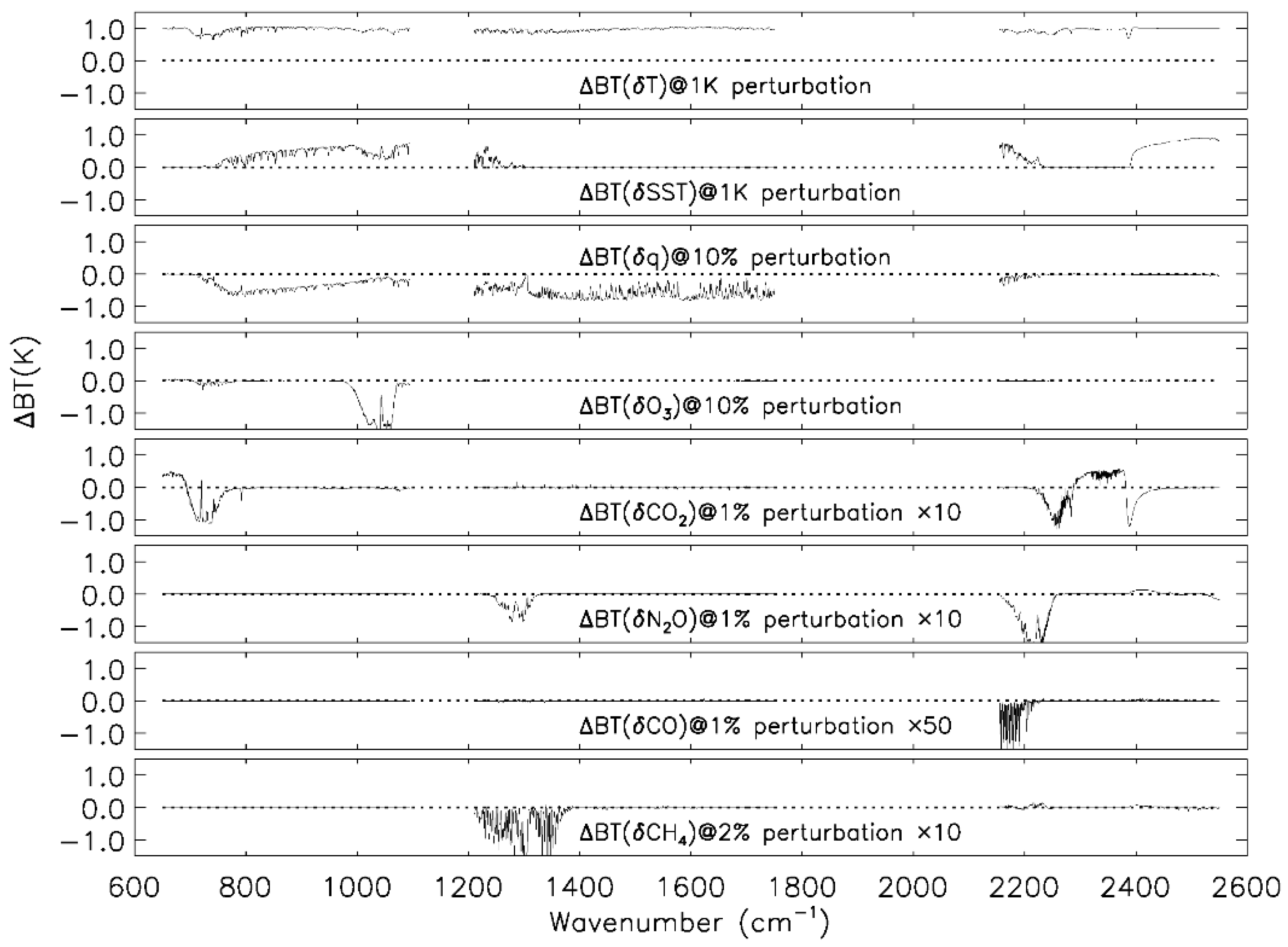




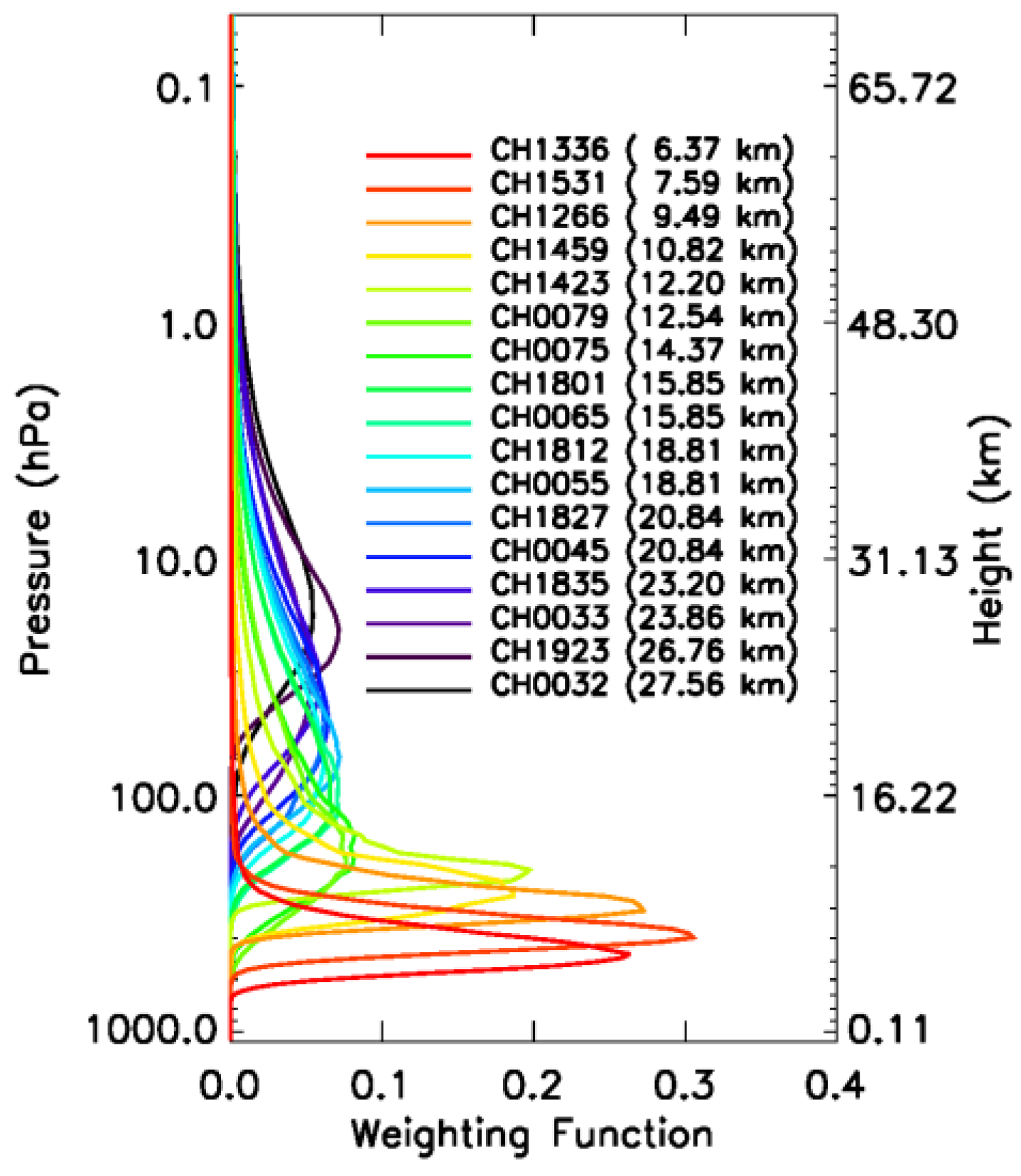
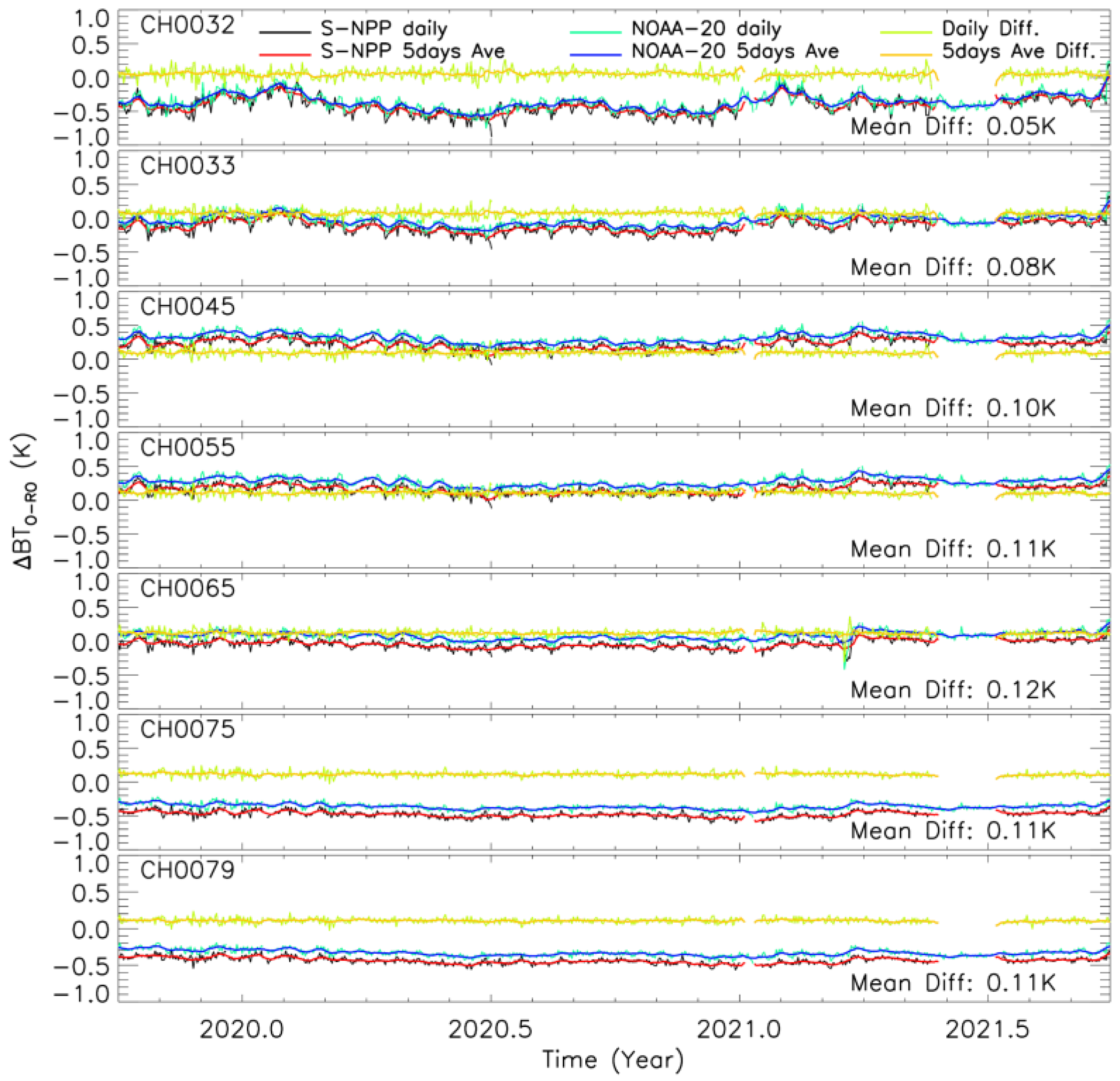
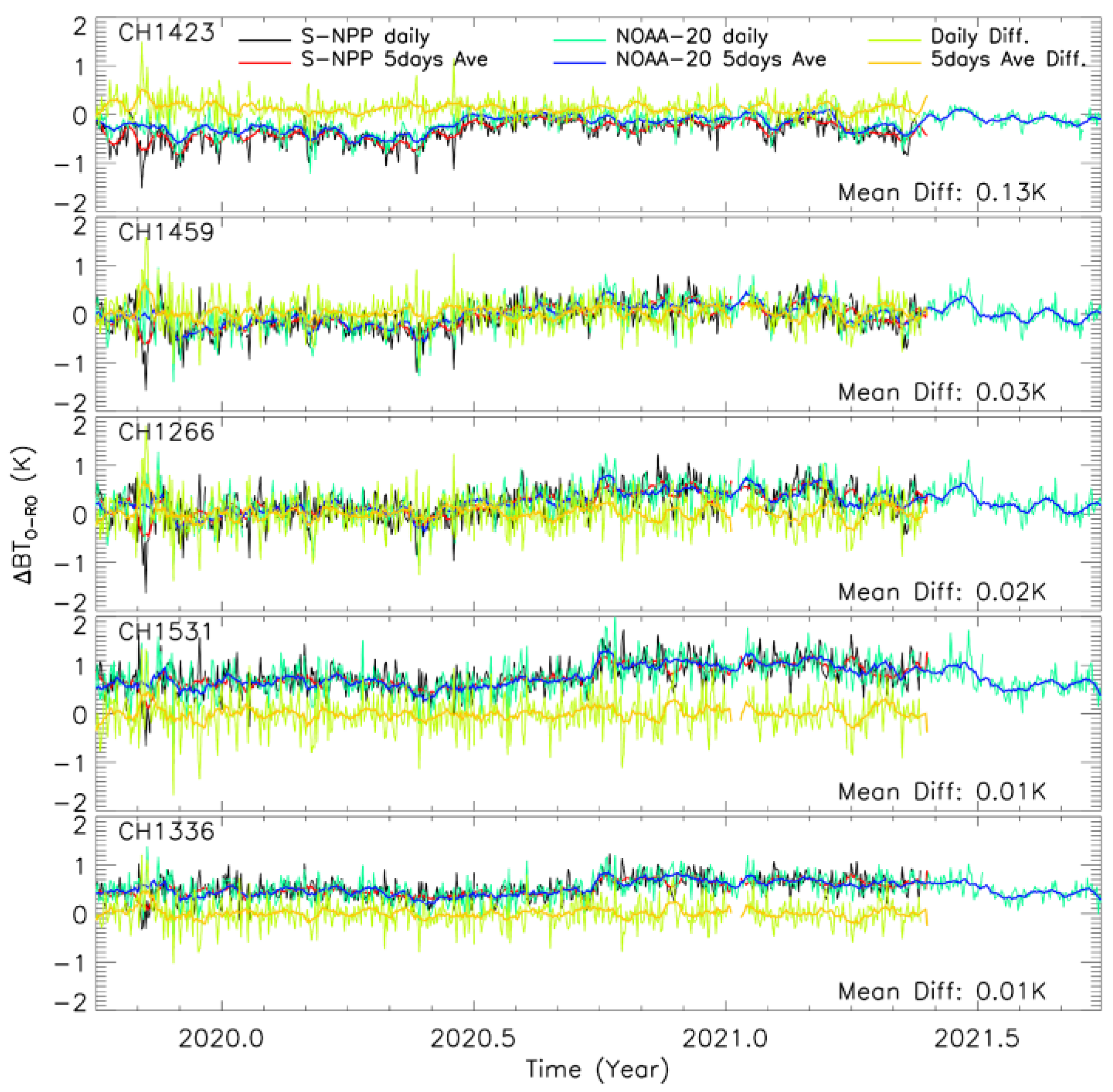
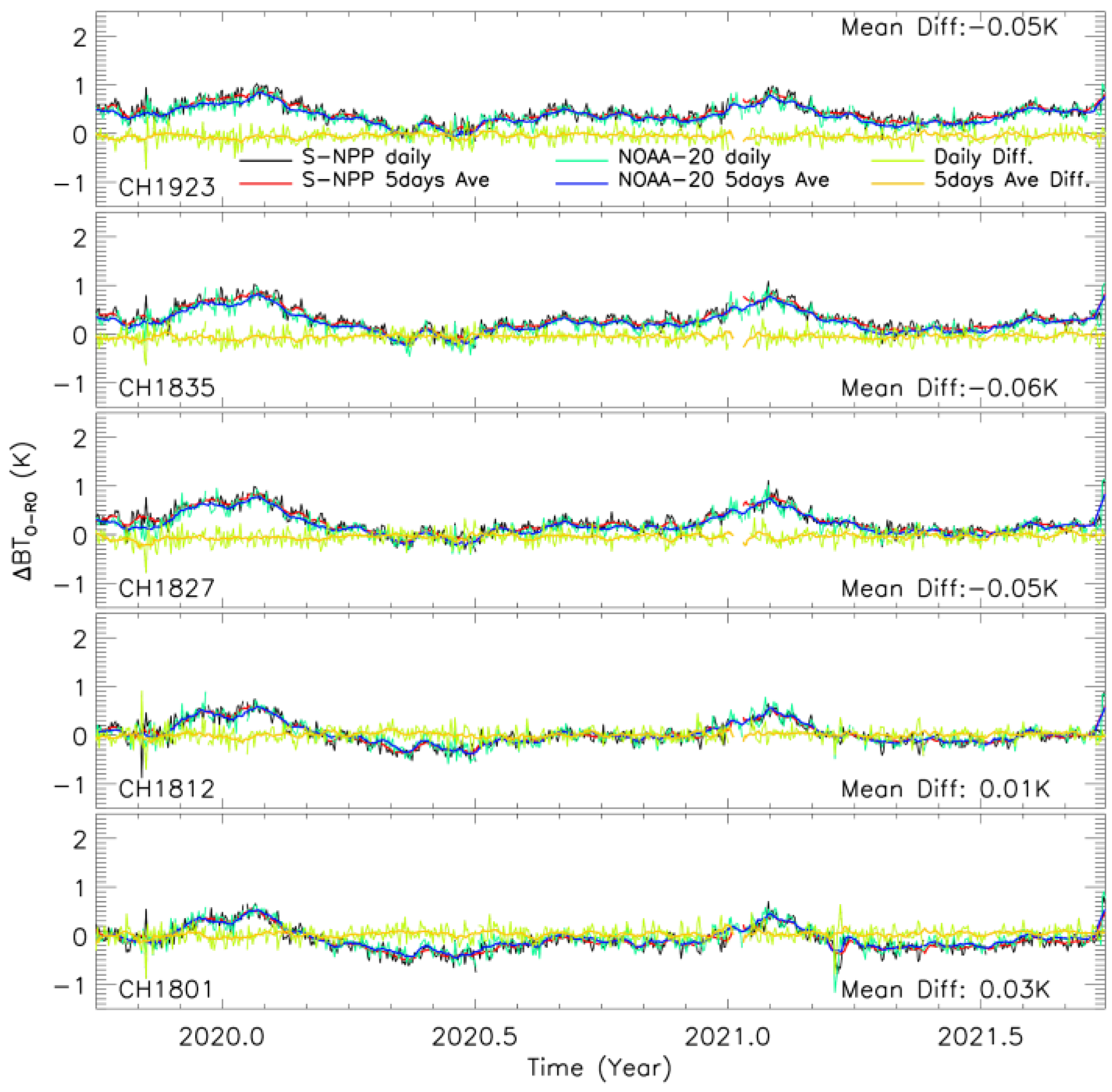
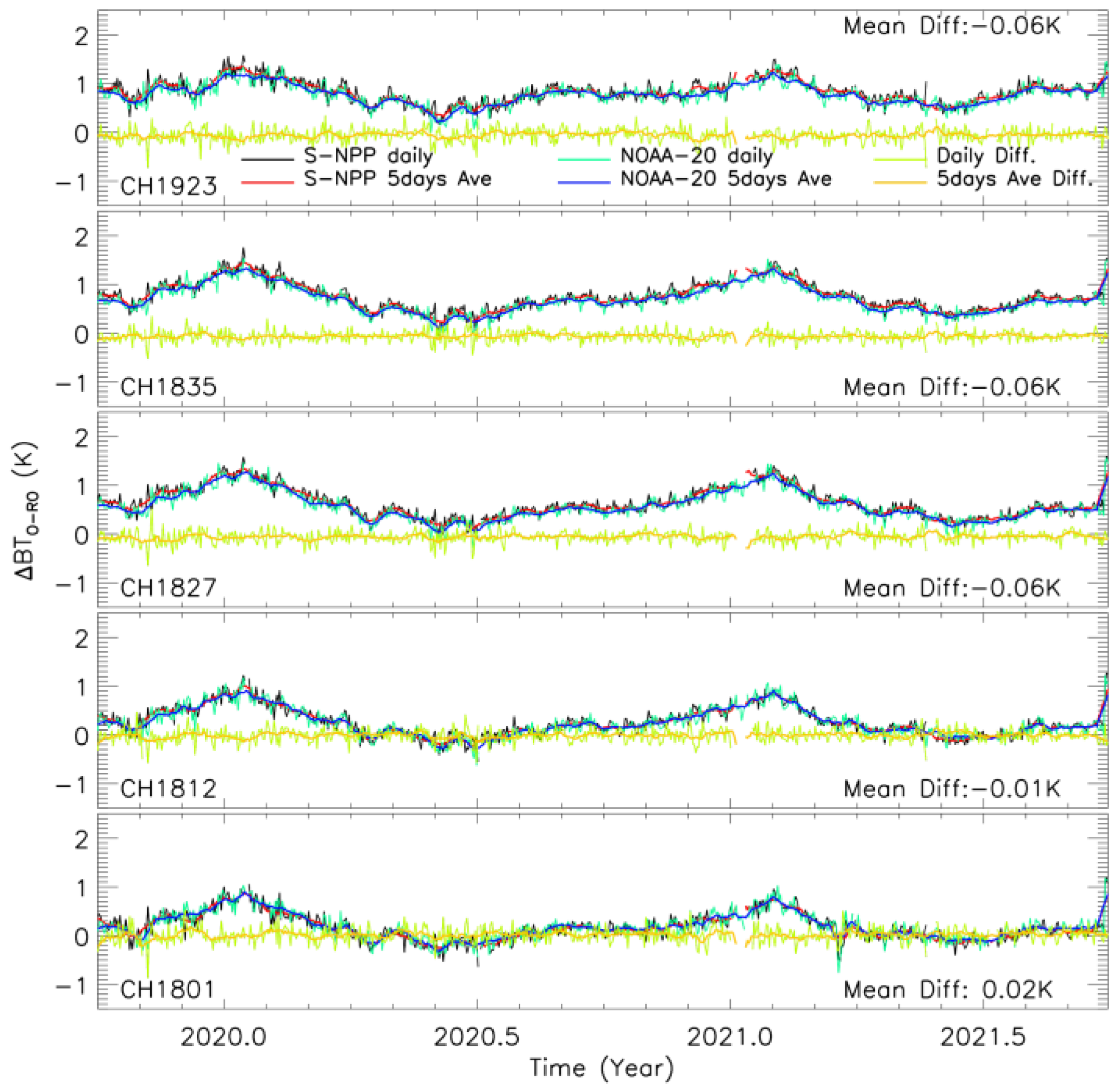
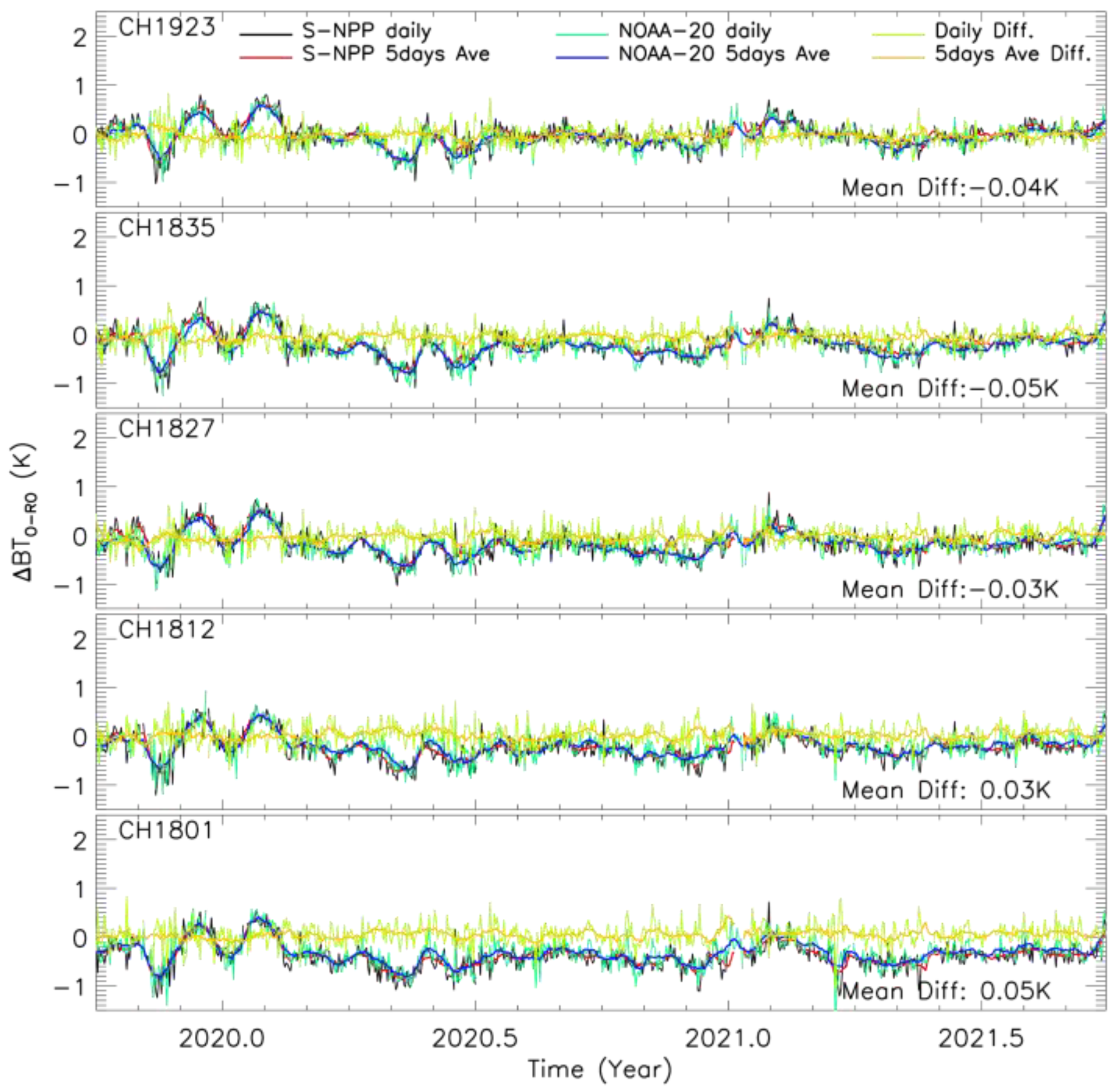
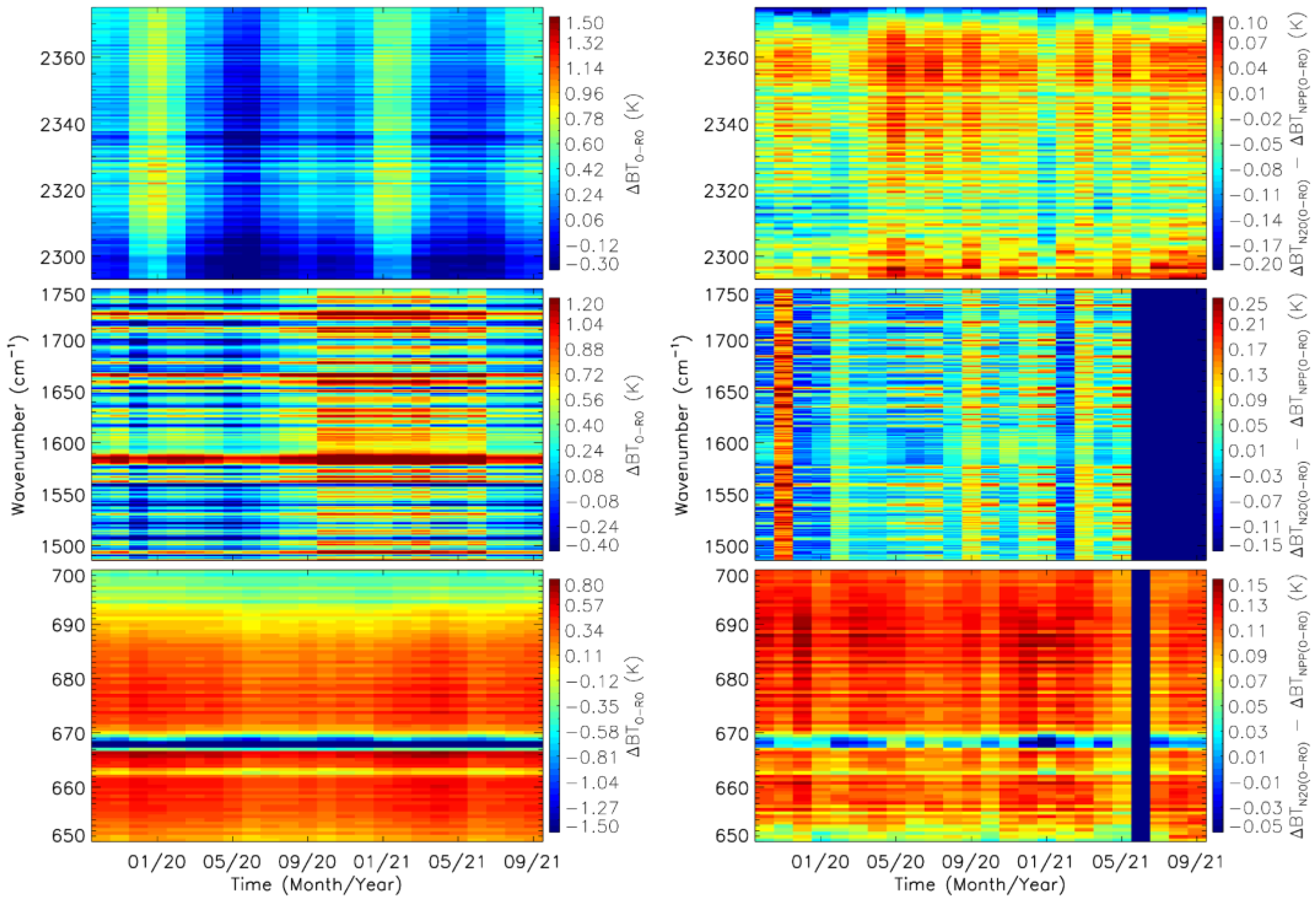
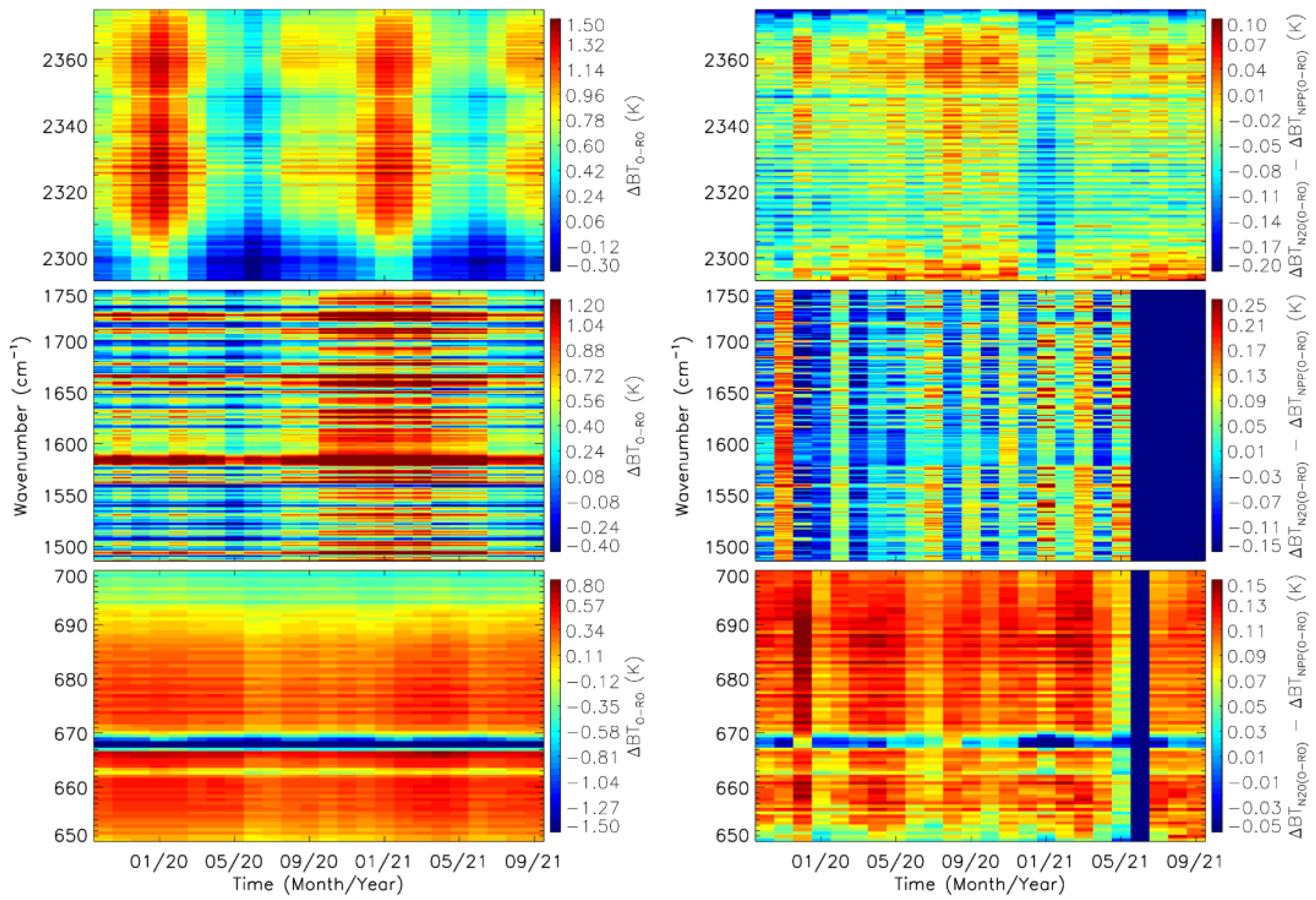
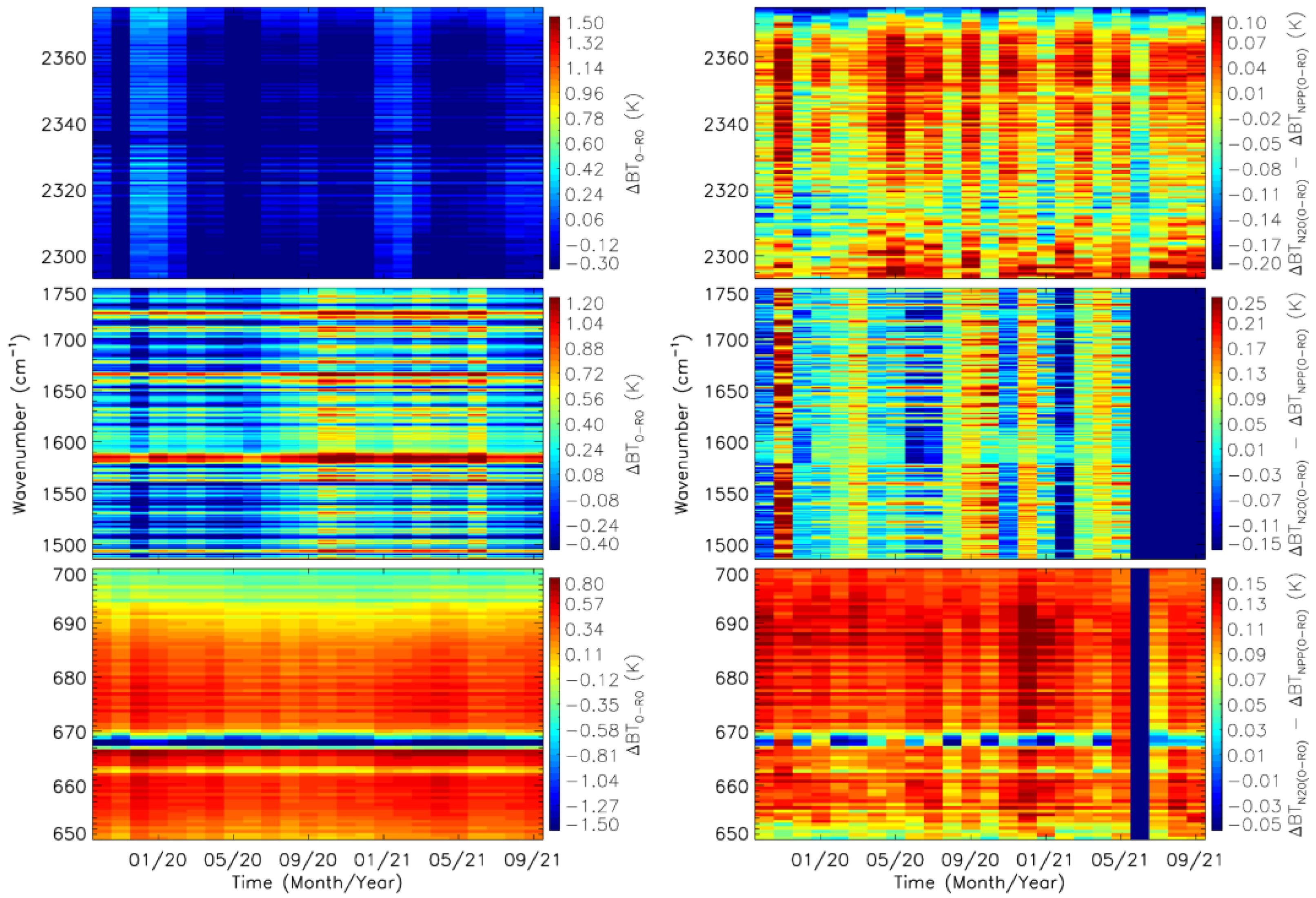
| CrIS Band | Channel Index | Channel Center Wavenumber (cm−1) | Peak Sounding Height (km) | Peak Sounding Pressure (hPa) |
|---|---|---|---|---|
| LWIR | CH0032 | 669.375 | 27.56 | 20 |
| CH0033 | 670.000 | 23.86 | 30 | |
| CH0045 | 677.500 | 20.84 | 50 | |
| CH0055 | 683.750 | 18.81 | 70 | |
| CH0065 | 690.000 | 15.85 | 100 | |
| CH0075 | 696.250 | 14.37 | 150 | |
| CH0079 | 698.750 | 12.54 | 200 | |
| MWIR | CH1266 | 1555.000 | 9.49 | 300 |
| CH1336 | 1598.750 | 6.37 | 500 | |
| CH1423 | 1653.125 | 12.20 | 200 | |
| CH1459 | 1675.625 | 10.82 | 250 | |
| CH1531 | 1720.625 | 7.59 | 400 | |
| SWIR | CH1801 | 2293.750 | 15.85 | 100 |
| CH1812 | 2300.625 | 18.81 | 70 | |
| CH1827 | 2310.000 | 20.84 | 50 | |
| CH1835 | 2315.000 | 23.20 | 30 | |
| CH1923 | 2370.000 | 26.76 | 20 |
Publisher’s Note: MDPI stays neutral with regard to jurisdictional claims in published maps and institutional affiliations. |
© 2022 by the authors. Licensee MDPI, Basel, Switzerland. This article is an open access article distributed under the terms and conditions of the Creative Commons Attribution (CC BY) license (https://creativecommons.org/licenses/by/4.0/).
Share and Cite
Chen, Y.; Cao, C.; Shao, X.; Ho, S.-P. Assessment of the Consistency and Stability of CrIS Infrared Observations Using COSMIC-2 Radio Occultation Data over Ocean. Remote Sens. 2022, 14, 2721. https://doi.org/10.3390/rs14112721
Chen Y, Cao C, Shao X, Ho S-P. Assessment of the Consistency and Stability of CrIS Infrared Observations Using COSMIC-2 Radio Occultation Data over Ocean. Remote Sensing. 2022; 14(11):2721. https://doi.org/10.3390/rs14112721
Chicago/Turabian StyleChen, Yong, Changyong Cao, Xi Shao, and Shu-Peng Ho. 2022. "Assessment of the Consistency and Stability of CrIS Infrared Observations Using COSMIC-2 Radio Occultation Data over Ocean" Remote Sensing 14, no. 11: 2721. https://doi.org/10.3390/rs14112721
APA StyleChen, Y., Cao, C., Shao, X., & Ho, S.-P. (2022). Assessment of the Consistency and Stability of CrIS Infrared Observations Using COSMIC-2 Radio Occultation Data over Ocean. Remote Sensing, 14(11), 2721. https://doi.org/10.3390/rs14112721







